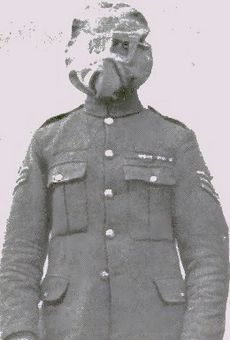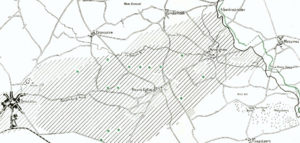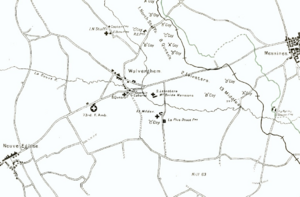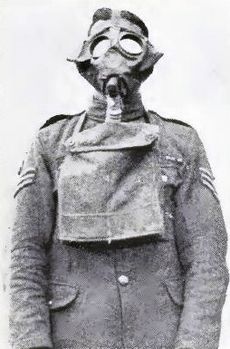Gas attacks at Wulverghem facts for kids
Quick facts for kids Gas attacks at Wulverghem |
|||||||
|---|---|---|---|---|---|---|---|
| Part of Local operations December 1915 – June 1916 Western Front, in the First World War | |||||||
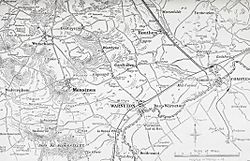 Wulverghem |
|||||||
|
|||||||
| Belligerents | |||||||
| Commanders and leaders | |||||||
| Strength | |||||||
| part of 2 regiments | part of 2 divisions | ||||||
| Casualties and losses | |||||||
| unknown | 30 April: 562 gas casualties 89 fatal 17 June: 562 gas casualties 95 fatal |
||||||
The Gas attacks at Wulverghem happened on 30 April and 17 June 1916. These were times when German forces released poisonous gas clouds during the First World War. The gas was aimed at British troops stationed at Wulverghem, a town near Ypres in Belgium.
These gas attacks were part of the smaller fights that happened between the bigger battles in the Ypres Salient. This area was a bulge in the battle lines on the Western Front. The British Second Army held the land from Messines Ridge northwards. Soldiers in this area had been warned that a gas attack might happen.
The gas used at Wulverghem was a mix of chlorine and phosgene. Phosgene is a much more dangerous gas. This mix had been used before, in December 1915. Because of earlier gas attacks, the British had time to get better gas masks. They also had other anti-gas gear and special safety rules. By April 1916, British soldiers had PH helmets. Some special troops, like machine-gunners, even had advanced box respirators.
The German gas attack on 30 April caused 562 British soldiers to be affected by gas. Sadly, 89 of them died. German raiding parties tried to find and destroy mine entrances, but the British fought them off. A second German attack on 17 June caused a similar number of gas casualties. But again, British patrols easily pushed back the Germans.
Background to Gas Warfare
Early Gas Attacks in 1915
The Second Battle of Ypres
On 22 April 1915, German soldiers released chlorine gas. This gas drifted into the positions of French troops. Many soldiers ran away from the gas cloud, leaving a gap in the Allied lines. The Germans did not have enough troops to follow up on this success. As soon as German soldiers tried to move into areas not hit by gas, Allied fire stopped them.
The gas was a surprise because soldiers had no protection against it. It also had a scary psychological effect. Soldiers could dodge bullets and shells, but gas seeped everywhere. It caused a terrible, slow, choking feeling. The gas was quickly identified as chlorine. The first mass-produced Allied anti-gas mask was a simple flannel bag. It was soaked in chemicals to help protect against the gas.
The First Phosgene Attack
On 19 December 1915, the German 4th Army used a new, more deadly gas at Ypres. It was a mix of chlorine and phosgene. The British knew about the attack beforehand from a captured German soldier. British anti-gas measures worked well. They stopped panic and prevented the defenses from collapsing.
Even though British gas masks were not treated for phosgene, they still helped. Only one British division had many gas casualties. This was because soldiers in reserve lines were not warned fast enough. A study found that 1,069 soldiers were affected by gas, and 120 of them died. After this, the Germans realized that gas alone could not win a battle.
Gas Attacks in 1916
Gas Attack at Hulluch
Another German gas attack happened from 27 to 29 April 1916. This was near Loos-en-Gohelle. Just before dawn on 27 April, German gas clouds hit British divisions. After the gas and artillery fire, German raiding parties tried to enter British lines.
Two days later, another gas attack happened. But this time, the wind blew the gas back over the German lines. This caused many German casualties. British troops also fired at the fleeing German soldiers. The gas was a mix of chlorine and phosgene. It was strong enough to get through the British PH gas helmets. Production of the M2 gas mask, which worked better, was sped up.
British Preparations on the Second Army Front
In late April 1916, the British Second Army held the front line. German observers on higher ground could see the British positions. On 29 April, two British divisions held this front. They had front and support trenches, strong points, and a reserve line.
The front had been mostly quiet, except for German artillery attacks. The British had dug defensive mines and planned a deeper system. This was to prepare for an attack to take back Messines Ridge. But German shelling made it hard to work on the mines.
The Gas Attacks
German Plans
The Germans placed gas cylinders along their front lines. These were opposite the British V Corps. German soldiers did not like gas operations. They had to carry the heavy cylinders and live next to them. Many soldiers got gas poisoning from cylinders damaged by British artillery. They even had to sleep wearing gas masks.
The plan was to release gas from 2,000 large and 3,000 small cylinders. This would last for 20–25 minutes. The sound of the gas release would be covered by rifle fire.
British Gas Safety Rules
The British had strict rules for gas safety after earlier attacks. An officer in each area watched the wind direction. If the wind was right for a gas attack, a "Gas Alert" was given. Sentries were posted near alarm horns or gongs. Gas masks and alarms were checked every twelve hours. All soldiers wore their gas masks ready to use.
Warnings Received by the British
From 20 to 30 April, the British knew a German gas attack was likely. British artillery fire caused gas cylinders in German lines to explode. Green-yellow clouds were seen. On 25 April, a gas alert was given when the wind changed.
On 26 April, two German soldiers gave up to the British. They said gas cylinders were ready to be used. As a safety step, the British filled in and hid their deep mine entrances. They also stopped some work parties to make sure everyone got a gas warning. On 29 April, two more Germans deserted. They warned that an attack was coming that night or early morning.
The British infantry had PH anti-gas helmets. But their trenches were very close to the German lines. This meant the gas would be very strong when it arrived. If the gas was released in the dark, seeing through the helmet eye-pieces would be hard.
The Attack on 30 April
Just after midnight, German rifle fire began. Soon after, gas was released along a 2 mi (3.2 km) front. The gas rose above head-height and was lit up by British flares. German rifle and machine-gun fire covered the sound of the gas. This also hid the sound of British alarm gongs.
For many British soldiers, the first warning was the smell. The gas arrived very quickly because the wind was fast and no man's land was narrow. The British put on their helmets. German artillery then began shelling behind the British front lines.
The gas release lasted from 15 to 40 minutes. It was densest where German raiding parties were. These parties often did not wear gas masks. When the British saw this, some took off their masks too. The gas cloud traveled fast, reaching Bailleul 6 mi (9.7 km) away in minutes.
After the gas, German parties tried to advance. But British troops in listening posts pushed them back. Later, larger raiding parties attacked. They tried to cut through British wire. On the British 3rd Division front, attackers were pushed back by machine-guns and grenades. On the 24th Division front, a raiding party got into a trench but was forced out. By 4:30 a.m., quiet returned.
The Attack on 17 June
On the night of 16/17 June, another German gas cloud was released. It was aimed at the same British brigades. The British had given a gas alert earlier that day. Just after midnight, sentries saw gas rising from the German trenches. They gave the warning.
The gas cloud was thick but moved slowly. This gave the British enough time to put on their anti-gas hoods. The gas was released for 50 to 60 minutes. It blew towards the south-east. Near the end, the gas began to blow back. The British artillery shelled the German front line. A few Germans tried to climb out of their trenches but were forced back.
Even though most soldiers got the warning, gas casualties were similar to the April attack. This led to the idea that the PH helmets were not good enough against very strong gas.
Aftermath
Casualties and Effects
On 30 April, 562 British soldiers were affected by gas, and 89 died. The 3rd Division had 69 gas casualties, and the 24th Division had 338. More casualties happened in the 24th Division because more troops were in the path of the gas. Some did not get warnings in time. German reports only mentioned one senior officer being wounded.
The gas attack on 17 June caused 562 British casualties, with 95 deaths. The 72nd Brigade had 348 gas casualties, mostly from one battalion.
The gas cloud turned plants yellow up to 1,200 yd (1,100 m) from the front line. Many rats in the trenches died. Animals like cows, calves, a horse, a pig, and hens were also killed in fields. Other animals showed signs of gas poisoning.
The gas was strong enough to be deadly for an unmasked person up to 9,000–10,000 yd (5.1–5.7 mi; 8.2–9.1 km) away. About 14,000 troops put on gas masks during the attack. Troops in the front line had little warning before the gas arrived. In some places, the gas cloud was seen as a white mist. A hissing sound was heard, but often drowned out by gunfire.
The standard anti-gas gear included PH helmets and "box respirators." Box respirators were for machine-gunners and signallers. The box respirator was very successful because it could be put on faster than the PH helmet.
Many gas casualties happened even with warnings. Some groups got late warnings or did not realize the danger. A few soldiers were caught asleep. The speed and strength of the gas meant that any delay in putting on a mask led to poisoning. Most casualties were in the front line trenches, closest to the German lines.
The gas might have been strong enough to get through helmets in the trenches closest to the release. However, one battalion had fewer casualties. This was because they kept their helmets ready. Also, the gas blew sideways, missing their rear areas.
Soldiers who were most affected had blue skin and foamy liquid from their mouth and nose. Some severe cases showed paleness and collapse, which is common with phosgene poisoning. In some cases, the blue skin turned pale before death. Soldiers who died quickly in the front line showed deep blue skin and lots of frothing. They also coughed a lot in the early stages. This showed that the gas cloud had a small amount of phosgene mixed with chlorine.
About twenty civilians were also affected by the gas. None were severely harmed. They had been taught gas safety and given respirators. They also protected themselves by closing windows and doors and sealing cracks with wet cloths. Many even wore anti-gas helmets indoors.
See also
- Phosgene attack 19 December 1915
- Gas attacks at Hulluch, 27–29 April 1916
Images for kids


